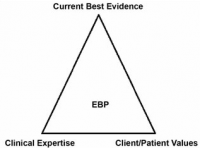
This opinion paper was originally posted as a downloadable PDF on my website, authored in mid- 2011. Download the original PDF here. *** What Evidence-Based Practice (EBP) Really Means Q: It is surprising to me that you find it reasonable to pass on non-evidence based ideas. I don’t think this meets a best practice standard at all. I’m curious to know how you demonstrate efficacy this way. The term “Evidence-Based Practice” has been bandied about and distorted. EBP does not mean that we only…
